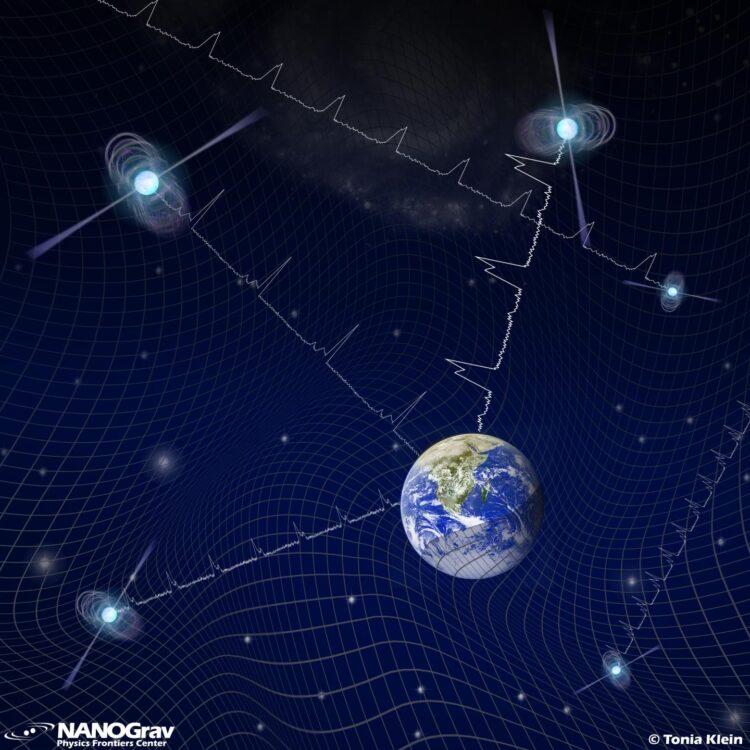The University is part of a team recently awarded a $17 million grant from the National Science Foundation
West Virginia University researchers are part of a team that was recently awarded $17 million from the National Science Foundation (NSF) for the renewal of the NANOGrav Physics Frontiers Center (PFC).
West Virginia University researchers Dr. Maura McLaughlin and Dr. Sarah Burke-Spolaor, both faculty in the Department of Physics and Astronomy in the Eberly College of Arts and Sciences, will direct WVU’s $3.9 million share of the award.
McLaughlin will also continue to serve as the NANOGrav PFC’s Co-Director in a new era of scientific discoveries, including a recently released data set that may indicate the first hints of the long sought-after gravitational wave background from supermassive black hole binaries.
NSF currently supports ten other PFCs, which range in research areas from theoretical biological physics and the physics of living cells to quantum information and nuclear astrophysics.
By bringing together astronomers and physicists from across the United States and Canada to search for the telltale signature of gravitational waves buried in the incredibly steady ticking of distant pulsars, the NANOGrav PFC will advance the mission to “foster research at the intellectual frontiers of physics” and to “enable transformational advances in the most promising research areas.”
NANOGrav PFC members Burke-Spolaor and McLaughlin, along with new Department of Physics and Astronomy faculty member Dr. Emmanuel Fonseca and several postdoctoral researchers, graduate students, and undergraduate students, search for small perturbations in the arrival times of pulses from rapidly spinning compact stars called pulsars. These ultra-stable stars are nature’s most precise celestial clocks, appearing to “tick” every time their beamed emissions sweep past the Earth, like the beacon on a lighthouse. Gravitational waves may be detected in the small but perceptible fluctuations–a few tens of nanoseconds over ten or more years–they cause in the measured arrival times at Earth of radio pulses from these millisecond pulsars. The NANOGrav PFC monitors these pulsars using large radio telescopes such as the Green Bank Telescope in Pocahontas County, West Virginia.
The gravitational waves that the team hopes to detect are likely to be emitted by supermassive binary black holes that form at the cores of merging massive galaxies. The detection of these gravitational waves will allow them to answer important questions about how galaxies have grown and evolved through cosmic time. “We are in an unprecedented era of discovery for pulsar timing arrays and, more broadly, gravitational waves,” states Burke-Spolaor. “Support by the PFC has provided us the resources to come together as a cogent collaboration, and push forward gravitational-wave science at low frequencies”. Jim Shank, the program director for NSF’s PFC program agrees, stating “The NANOGrav PFC has made significant progress over the last five years, remaining at the frontier of fundamental physics research. The center now seems close to making a breakthrough discovery in gravitational waves and the way we perceive the universe.”
NANOGrav’s ambitious science goals are accompanied by a comprehensive education and outreach program, developing rich mentoring and networking opportunities for graduate students and postdocs in WV, who are moving on to be strong contributors to the STEM workforce in academia and industry. McLaughlin also explains that “the NANOGrav PFC also aims to increase the involvement of high-school and undergraduate students in our project, specifically those who are traditionally under-presented in physics and astronomy, through innovative outreach and education programs.
Both McLaughlin and Burke-Spolaor are researchers in the Center for Gravitational Waves and Cosmology which formed in 2015 along with the initial award of the NANOGrav PFC. The collaborative nature of the consortium provides unique opportunities for Centers to support NANOGrav’s missions to “foster research at the intellectual frontiers of physics” and to “enable transformational advances in the most promising research areas.”
###
Media Contact
Holly Legleiter
[email protected]
Original Source
https:/





